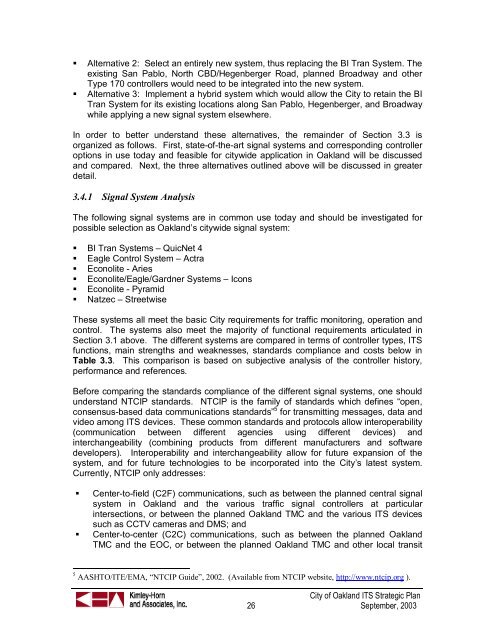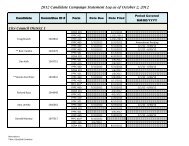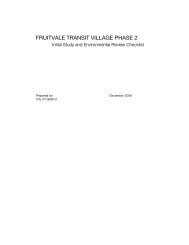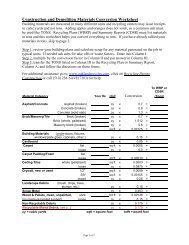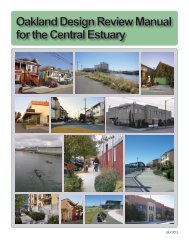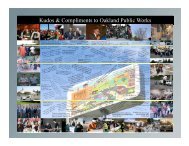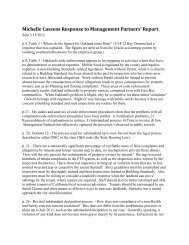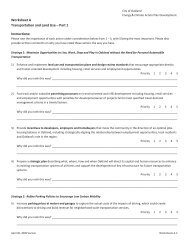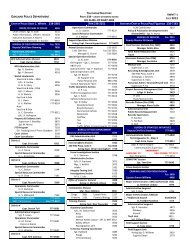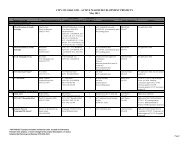Intelligent Transportation Systems - City of Oakland
Intelligent Transportation Systems - City of Oakland
Intelligent Transportation Systems - City of Oakland
You also want an ePaper? Increase the reach of your titles
YUMPU automatically turns print PDFs into web optimized ePapers that Google loves.
• Alternative 2: Select an entirely new system, thus replacing the BI Tran System. The<br />
existing San Pablo, North CBD/Hegenberger Road, planned Broadway and other<br />
Type 170 controllers would need to be integrated into the new system.<br />
• Alternative 3: Implement a hybrid system which would allow the <strong>City</strong> to retain the BI<br />
Tran System for its existing locations along San Pablo, Hegenberger, and Broadway<br />
while applying a new signal system elsewhere.<br />
In order to better understand these alternatives, the remainder <strong>of</strong> Section 3.3 is<br />
organized as follows. First, state-<strong>of</strong>-the-art signal systems and corresponding controller<br />
options in use today and feasible for citywide application in <strong>Oakland</strong> will be discussed<br />
and compared. Next, the three alternatives outlined above will be discussed in greater<br />
detail.<br />
3.4.1 Signal System Analysis<br />
The following signal systems are in common use today and should be investigated for<br />
possible selection as <strong>Oakland</strong>’s citywide signal system:<br />
• BI Tran <strong>Systems</strong> – QuicNet 4<br />
• Eagle Control System – Actra<br />
• Econolite - Aries<br />
• Econolite/Eagle/Gardner <strong>Systems</strong> – Icons<br />
• Econolite - Pyramid<br />
• Natzec – Streetwise<br />
These systems all meet the basic <strong>City</strong> requirements for traffic monitoring, operation and<br />
control. The systems also meet the majority <strong>of</strong> functional requirements articulated in<br />
Section 3.1 above. The different systems are compared in terms <strong>of</strong> controller types, ITS<br />
functions, main strengths and weaknesses, standards compliance and costs below in<br />
Table 3.3. This comparison is based on subjective analysis <strong>of</strong> the controller history,<br />
performance and references.<br />
Before comparing the standards compliance <strong>of</strong> the different signal systems, one should<br />
understand NTCIP standards. NTCIP is the family <strong>of</strong> standards which defines “open,<br />
consensus-based data communications standards” 5 for transmitting messages, data and<br />
video among ITS devices. These common standards and protocols allow interoperability<br />
(communication between different agencies using different devices) and<br />
interchangeability (combining products from different manufacturers and s<strong>of</strong>tware<br />
developers). Interoperability and interchangeability allow for future expansion <strong>of</strong> the<br />
system, and for future technologies to be incorporated into the <strong>City</strong>’s latest system.<br />
Currently, NTCIP only addresses:<br />
• Center-to-field (C2F) communications, such as between the planned central signal<br />
system in <strong>Oakland</strong> and the various traffic signal controllers at particular<br />
intersections, or between the planned <strong>Oakland</strong> TMC and the various ITS devices<br />
such as CCTV cameras and DMS; and<br />
• Center-to-center (C2C) communications, such as between the planned <strong>Oakland</strong><br />
TMC and the EOC, or between the planned <strong>Oakland</strong> TMC and other local transit<br />
5 AASHTO/ITE/EMA, “NTCIP Guide”, 2002. (Available from NTCIP website, http://www.ntcip.org ).<br />
<strong>City</strong> <strong>of</strong> <strong>Oakland</strong> ITS Strategic Plan<br />
26 September, 2003


